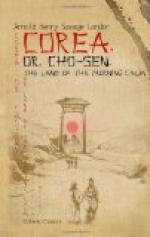There are two free nights, besides, on the fourteenth and fifteenth days of the first moon, and on one of the days at “half-year” in the sixth moon. That is all.
[Illustration: THE MARBLE PAGODA]
At no great distance from the “big bell,” down a tortuous little lane, we come to what is undoubtedly a very ancient work of art. This is a pagoda, made of solid marble, and adorned with beautiful carvings all the way up to the top. To me this pagoda seemed to be of Chinese origin, but, though much speculation has been exercised in Seoul as to how so strange a monument came to be placed in the Corean capital, no reliable data, or facts that might be considered of historical value, have as yet been forthcoming to explain satisfactorily its presence there. Beyond wondering at its antiquity, therefore, and admiring the skilful bas-relief upon it, there is little more for us to do; so, moving out of the courtyard in which this pagoda is situated, we proceed to inspect another monument, equally curious from an archaeological point of view.
It cannot but seem strange that the Coreans should be ignorant regarding the little pagoda above mentioned. I call it “little,” for I do not think it stands more than fifteen or twenty feet from the base to the top. Probably in Seoul itself there is not more than one man out of fifty who knows of its existence, and those who are acquainted with it, beyond telling you emphatically that it is not a Corean work, can give you no information about it. It is not improbable that, in the course of some friendly or unfriendly intercourse between the Chinese and the Coreans, this pagoda was brought or sent over from China.
The other curiosity is a huge stone tortoise carrying a tablet on its back.
As I have already mentioned, the Coreans in many ways resemble, and have appropriated or carried with them to their place of settlement some ideas which are common to the Manchus, the Mongols, and the Northern and Southern Chinese. Among these may be instanced the great respect for, if not worship of, fetishes and rudely made images of animals, both imaginary and real, which are supposed to be embodied there with all their good and evil qualities. The Coreans have an especial veneration for the tiger, the emblem of supernatural strength, courage and dignity. Now when veneration comes into play, the extraordinary, as a rule, soon takes the place of the ordinary, especially in the Eastern mind, which is rather addicted to letting itself be run away with by its imagination. So the tiger, as though it were not sufficiently gifted already with evil qualities of a more mundane order, is often depicted by native geniuses, as having also the power of flying, producing lightning, and spitting fire; and not only that, but as able to walk on flames without feeling the slightest inconvenience, and manipulate blazing fire as one would a fan in everyday use. On flags, pictures, and embroideries the tiger is often represented by native artists.




